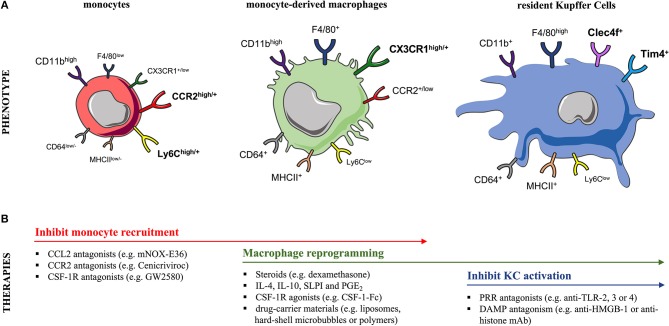Figure 2.
Murine monocyte and liver macrophage subsets and targeted therapeutic strategies. (A) In mice, (left) blood and liver-infiltrating monocytes differentially express the markers Ly6C, CCR2, and CX3CR1. During steady-state, the liver macrophage pool can be expanded due to recruitment of circulating (CCR2+) Ly6Chigh monocytes, a process markedly increased after injury. Following their infiltration, monocytes undergo a maturation process into (middle) (CX3CR1+) Ly6Clow monocyte-derived macrophages (MoMFs) that exhibit a CD11bhigh F4/80+ profile. In contrast, the (right) embryonically derived (CX3CR1−) liver-resident Kupffer cells (KCs) are CD11b+ F4/80high cells expressing the prototypical markers Clec4F and Tim4. Markers designated in bold are currently used to distinguish these two subsets. (B) The table summarizes therapeutic interventions targeting monocyte recruitment, macrophage polarization/differentiation or KC activation in experimental models of acute liver injury. CCL2, CC-chemokine ligand 2; CCR2, CC-chemokine receptor 2; CD, cluster of differentiation; Clec4F, C-type-lectin-domain-family-4-member-F; CSF1R, macrophage colony-stimulating-factor-1 receptor; CX3CR1, CX3C-chemokine receptor 1; DAMP, damage-associated molecular pattern; HMGB-1, high-mobility group box-1; IL, interleukin; MHCII, major histocompatibility complex class II; PRR, pattern-recognition receptor; PGE2, prostaglandin E2; SLPI, secretory leukocyte protease inhibitor; Tim-4, T-cell-immunoglobulin-and-mucin-domain-containing-4; TLR, Toll-like receptor.

